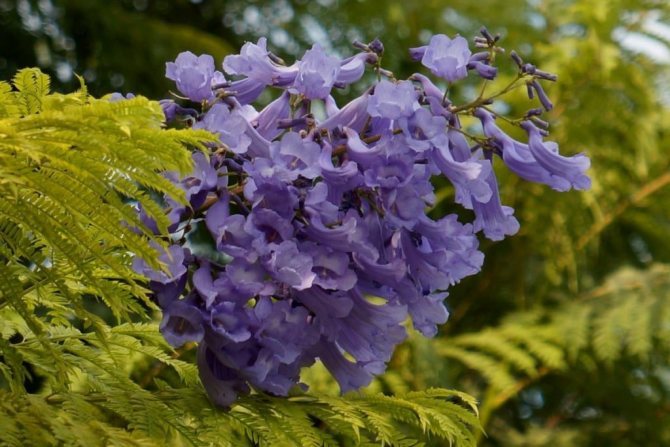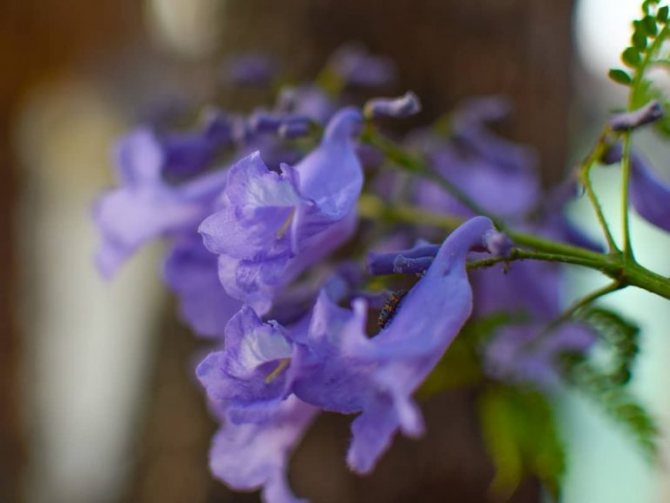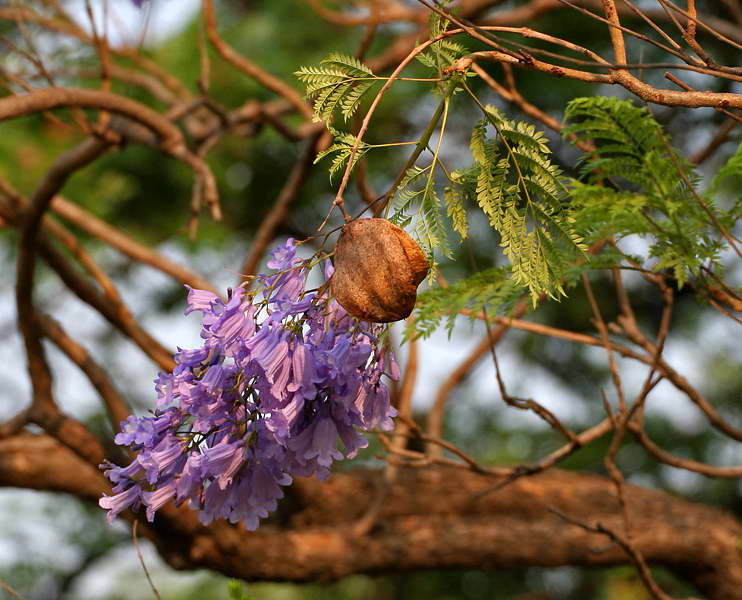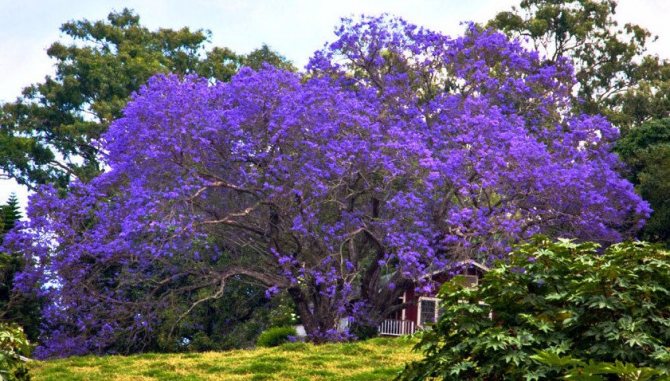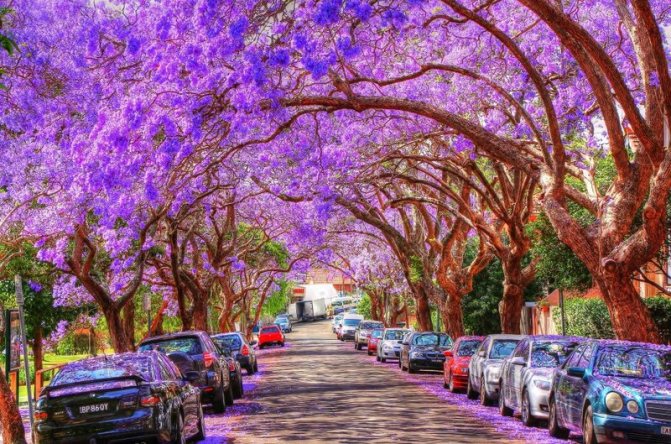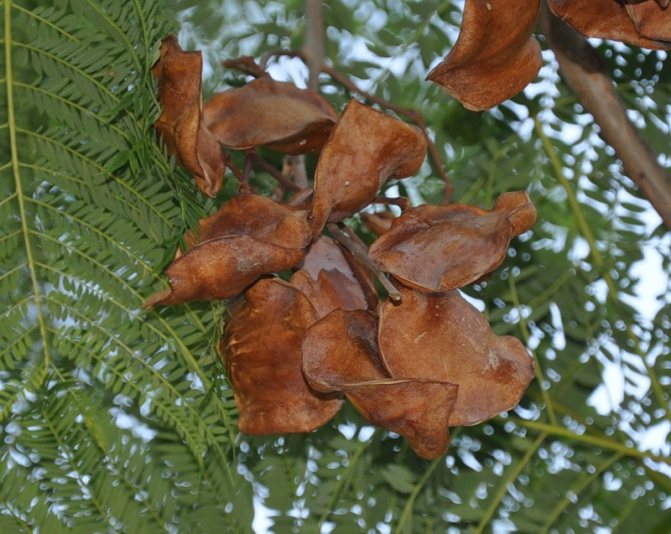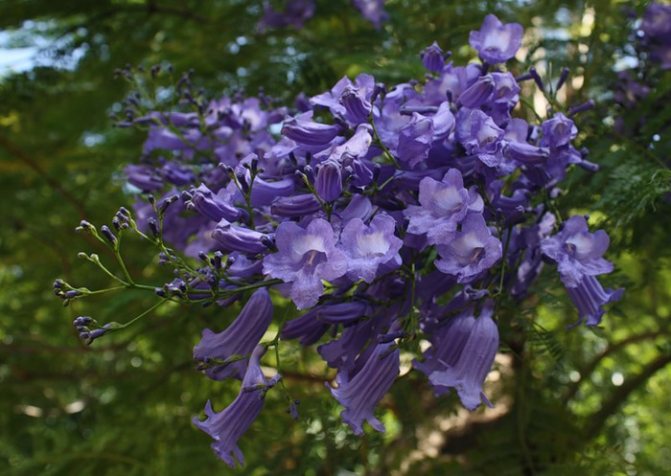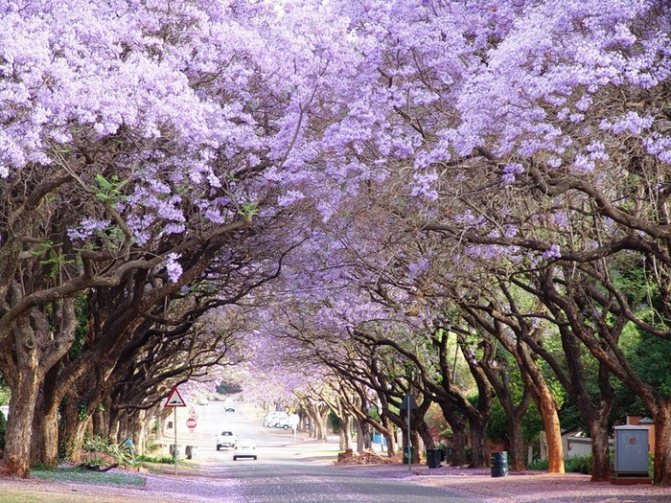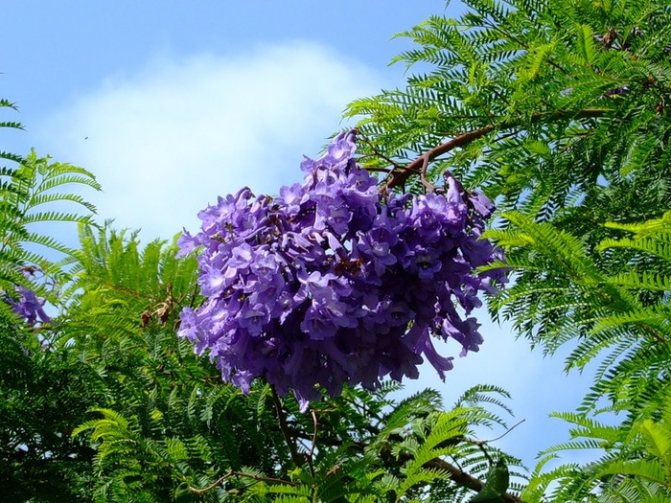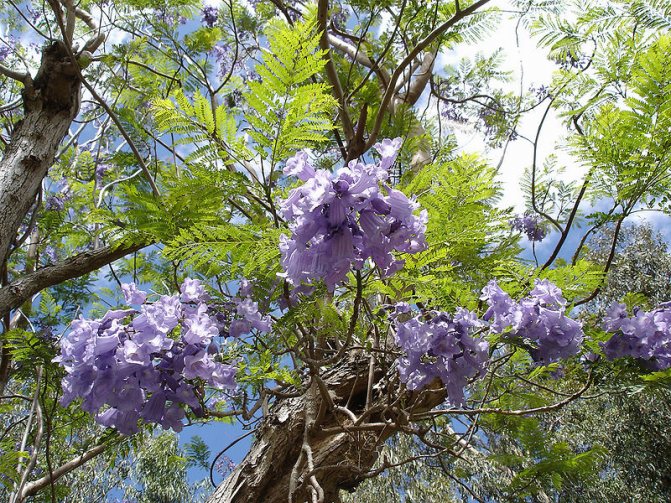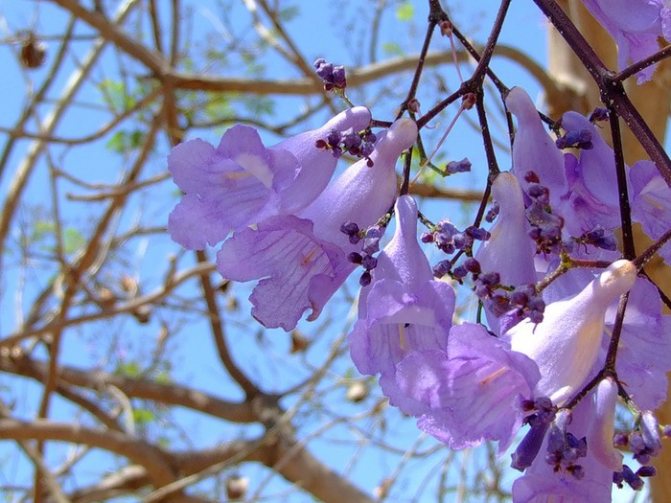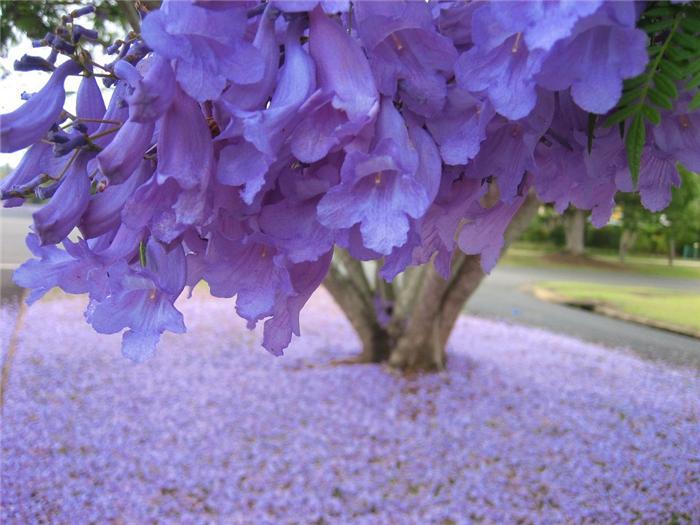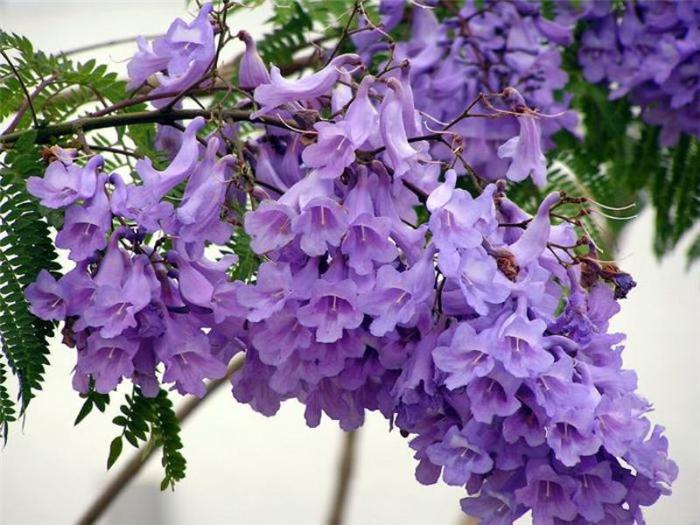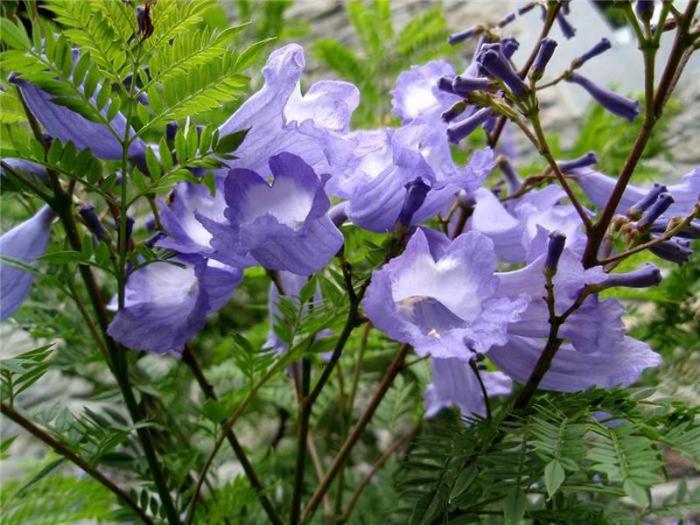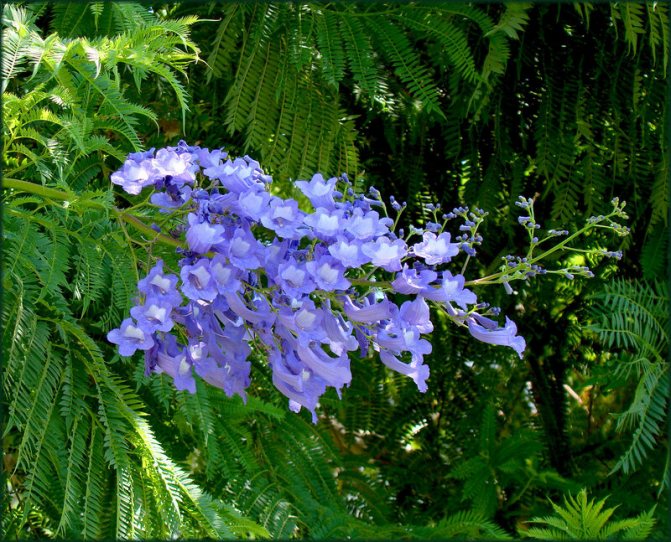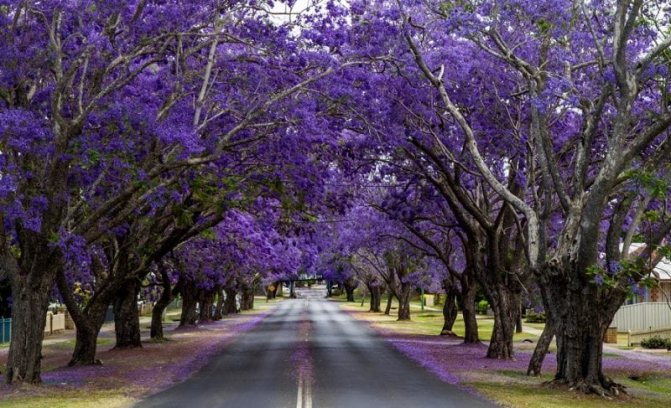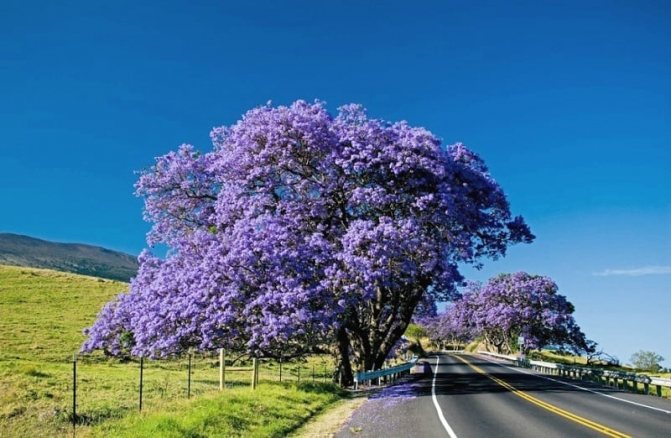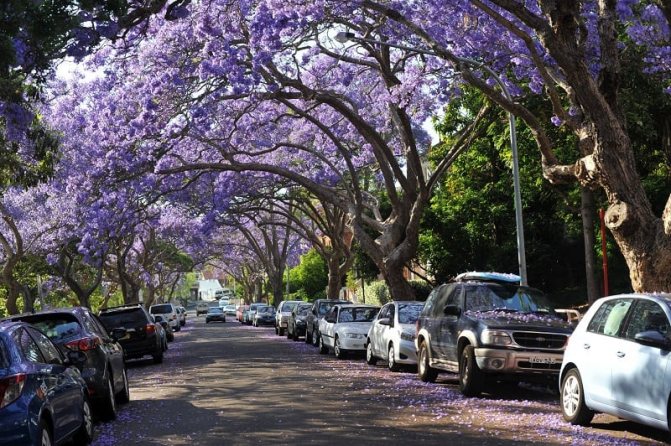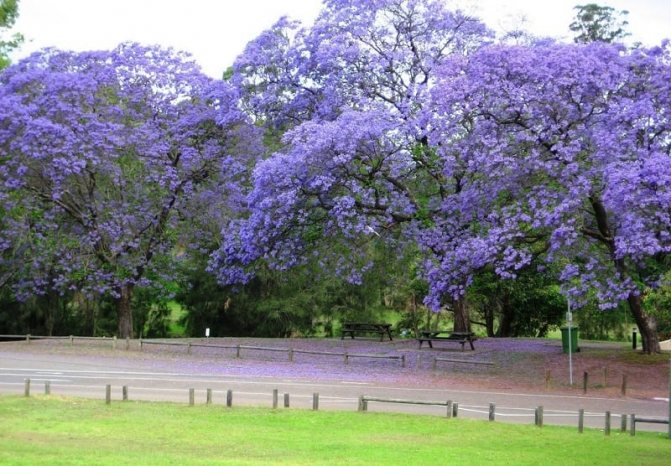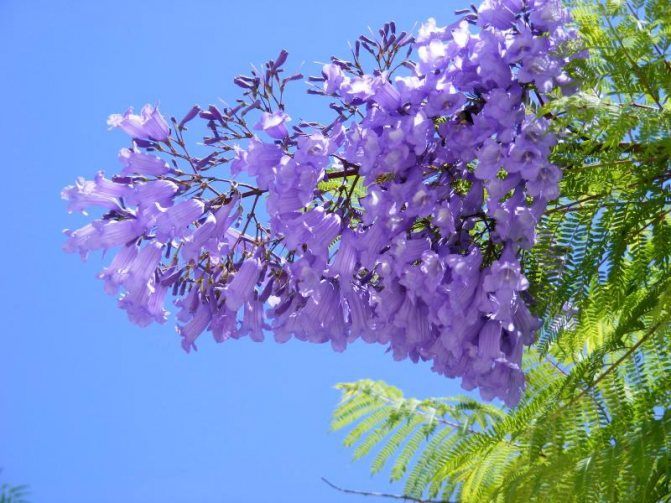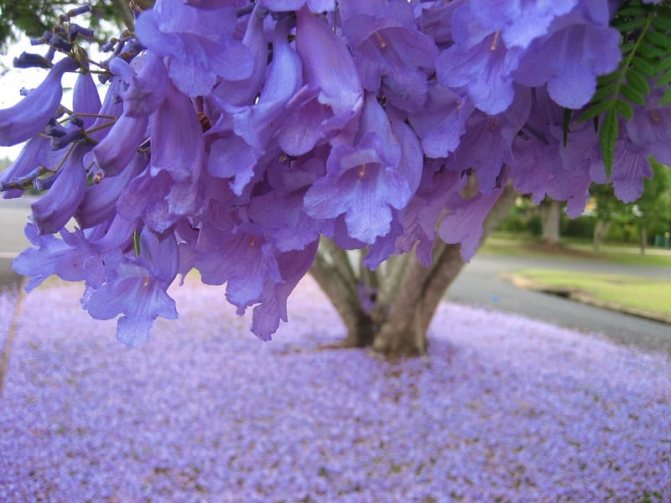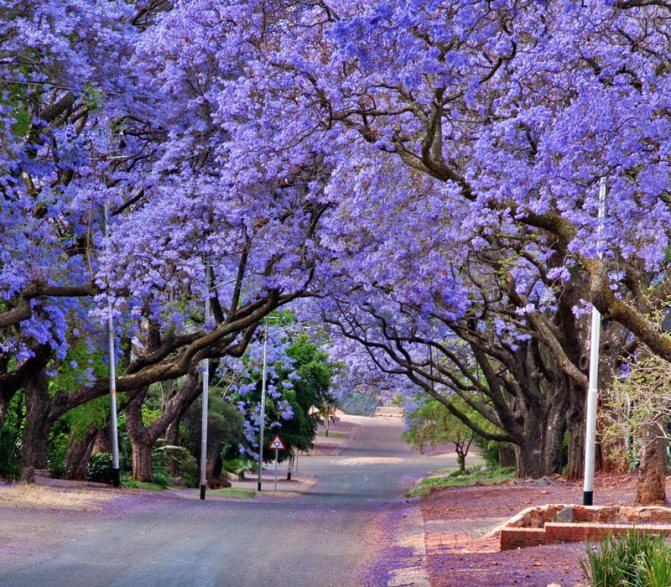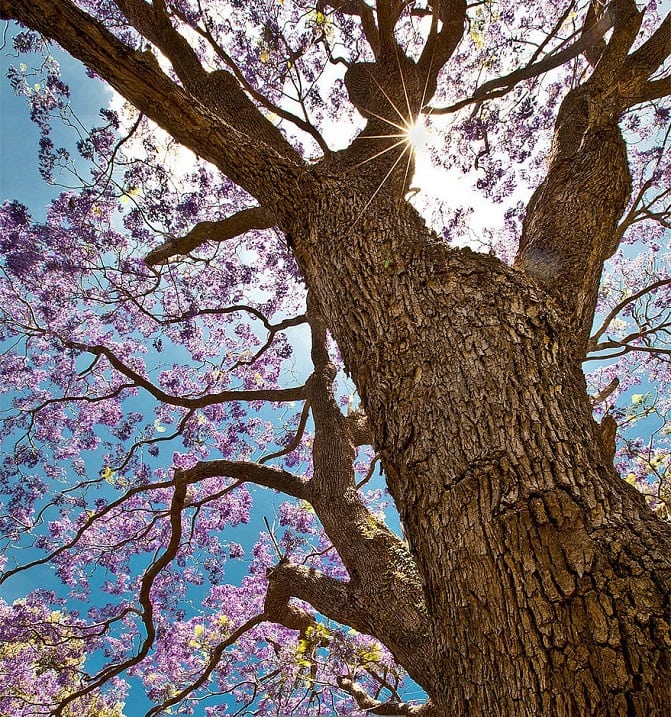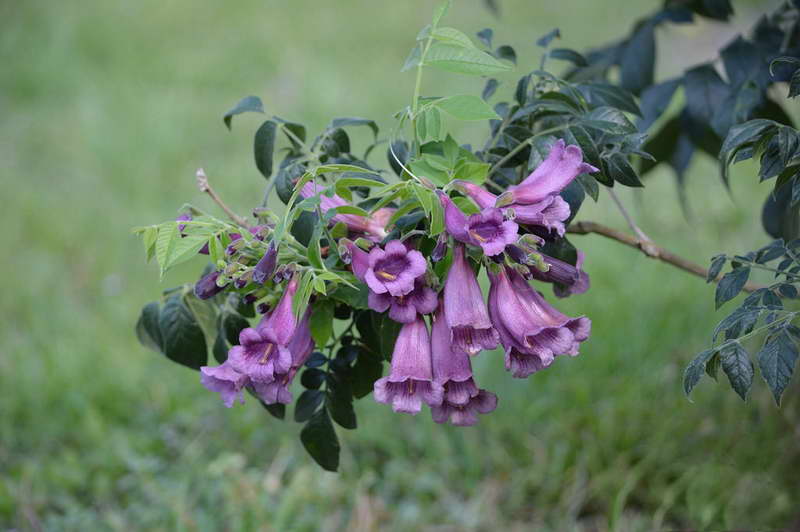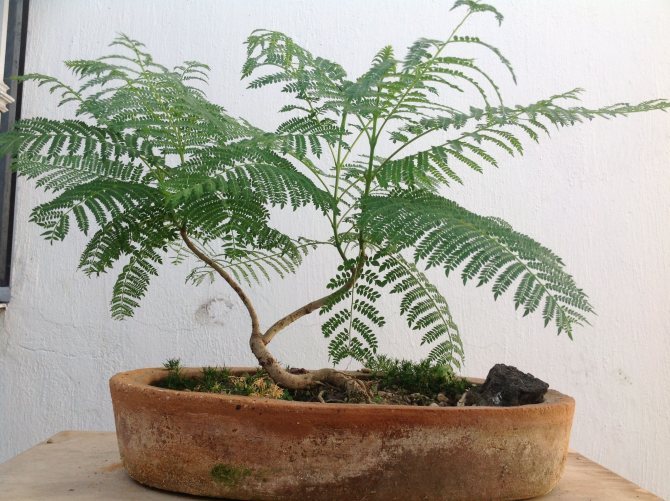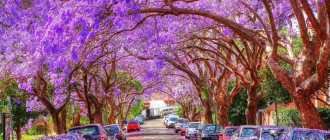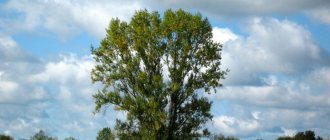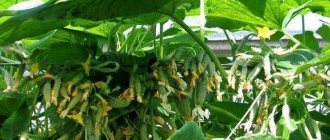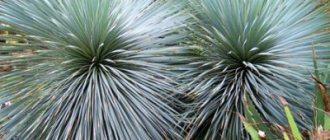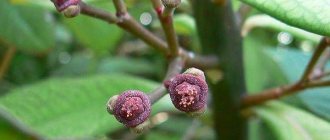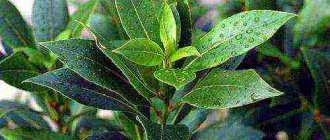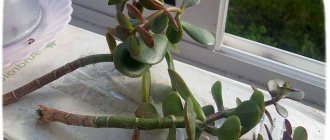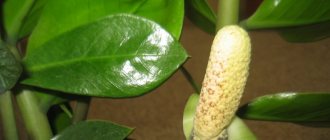This plant is represented by herbaceous perennials, trees, and shrubs. The opposite leaves are pinnate. The inflorescences are located at the top of the shoots and look like a panicle, or they grow from the leaf sinuses. Tubular flowers are blue or purple in color.
There are many species that have very valuable wood, besides the plants themselves have a very spectacular appearance. Only young plants are suitable for growing at home.
Jacaranda care at home. In detail
To make jacaranda feel like a welcome guest at home, develop harmoniously and want to bloom, you need to find a "key" for it and create optimal conditions for it.
Jacaranda bloom
In nature, the bloom of jacaranda is an amazing sight. Tall trees, densely covered with beautiful flowers resembling bells, collected in elongated loose panicles. Formed in the axils of leaves or at the tips of refined shoots, they can be painted in blue, dark blue, purple, lavender, or a mixture of their shades. Flowers have a pleasant smell of fresh honey and actively attract insects. The drooping panicles look very impressive against the background of bright green openwork foliage. Jacaranda blooms extremely rarely at home. To see the flowering of the plant, one must go to the botanical garden.
Temperature regime
Homemade Jacaranda is a guest from the tropics, so it loves warmth. When caring for an exotic, it is very important to observe the temperature regime. In summer, the plant is kept at + 25 ° C. In winter, during rest, Jacaranda feels normal at room temperature. It can withstand short-term temperature drop up to + 13 ° С.
Spraying
The tree has tropical roots, so its craving for increased - up to 65 - 70% - indoor air humidity is understandable. Caring for jacaranda at home involves daily spraying with settled lukewarm water. The procedure is carried out in the evenings so that bright sunlight does not fall on the wet leaves of the plant.
To maintain the air humidity at the proper level, an open container of water is placed next to the plant, and air humidifiers are used. The plant pot is placed on a tray with damp pebbles.
Lighting
We must try to ensure that the jacaranda plant at home receives about 3.5 hours a day bright lighting. The rest of the time, the shrub needs diffused bright lighting. In winter, bright lighting is especially important for jacaranda. The plant is placed on windows facing east or southeast.
In order for the crown of the jacaranda to develop symmetrically, the pot with the tree is periodically turned around its axis, exposing one or the other side to the sun.
Watering jacaranda
Jacaranda is a moisture-loving plant. In summer, watering jacaranda is carried out every three days. During the rest of the year, care must be taken to ensure that no crust forms on the surface of the substrate. Watered with lukewarm, well-settled water.To keep moisture longer, the trunk circle is mulched with coconut substrate, crushed sphagnum or spruce bark.
Jacaranda pot
For a tree, the choice of a container in which it will grow is of great importance. The jacaranda pot should not be too large: in it, the plant will look like a tall, thin teenager with an awkward figure. The container needs a wide and shallow one, it is also necessary to take into account the drainage layer, which is necessarily poured onto the bottom. When replanting a tree, the pot is replaced with a container, the diameter of which is 30 mm larger than the previous one.
Priming
For jacaranda, the soil is prepared independently from a mixture of two parts of leafy earth, 0.5 parts of sand and one part of humus, peat, turf soil taken one at a time. The substrate should be light and nutritious. To enhance the drainage properties, add brick chips, vermiculite.
Top dressing and fertilization
During the autumn and winter, fertilizing and fertilization of jacaranda is not carried out. In spring and summer, the plant is fed once every 4 weeks with a complex liquid fertilizer diluted in half.
The procedure is combined with watering so that nutrients reach the roots faster. When the jacaranda sheds its foliage (in late winter or early spring), it is also not fertilized.
Jacaranda transplant
Young plants are replanted every spring. A jacaranda transplant in adulthood is carried out every three years. They are transplanted carefully, without deepening the root collar, so as not to bury the growth point, otherwise the jacaranda will stop developing. The diameter of the new pot should be 3 cm larger than the diameter of the previous pot. When transplanting, much attention is paid to drainage: they improve the looseness of the substrate and make sure that there are drainage holes at the bottom of the pot.
Pruning
In winter, jacaranda throws off foliage, new leaves grow in spring. The plant is pruned every spring. The tips of the shoots are shortened to form a spectacular crown. By pinching it is possible to achieve a beautiful branching of the tree.
Optimal growing conditions in the home
The violet tree is also grown at home. But only young plants are suitable for this.
Lighting
The best place for the growth of an exotic plant is considered west and east windows... They have enough light that the jacaranda needs. On the southern windows, it should be shaded a little at noon, although a couple of hours a day in direct sunlight will not do any harm.
The acquired tree must be gradually accustomed to the sun in order to avoid burns on the leaves. The pot with the plant is sometimes scrolled, as it stretches towards the light, thereby deforming the crown and losing its decorative qualities.

Temperature
The violet tree is thermophilic, so the room temperature is should not fall below + 15 ° С - this will lead to the death of the plant. From autumn to spring, jacaranda can be grown at + 19 ° C, and the rest of the time - at + 24 ° C.
You can create a mini-garden in the room of tiny trees and shrubs using Japanese spirea, Persian lilac, Thunberg barberry, euonymus, larch, cotoneaster.
Interesting facts related to the plant
The rosewood tree is not only an ornamental house plant. Certain types of this plant are especially valuable, because they are used in the production of many household items. The tree itself is incredibly heavy and durable, and most importantly expensive, which is why it is more appreciated.
Each city and state has its own signs and superstitions associated with jacarand. For example, in Australia, during the flowering of this tree, exams always begin, and graduation is completed. Therefore, this tree is often considered part of student cultures. In student circles, jacaranda is often referred to as an examination plant.Some students are convinced that the plant brings good luck, and the person on whom the rosewood whisk falls will successfully complete the academic year.
But, in the opinion of others - this tree is "lilac panic". There is a custom that indicates that while the jacaranda has not bloomed, it is far from the exams, and therefore prepares early. Well, when the flowers have already blossomed, it is time for exams and it is already too late to prepare. Despite being superstitious, all Australians take this plant very seriously.
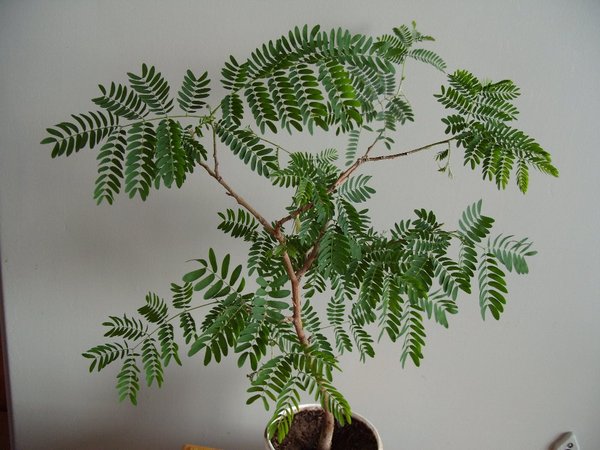

Also, for many Australian residents, jacaranda is considered a symbol of new life. Many are sure that after the birth of a baby, this tree simply needs to be planted on your site. No one can explain what exactly this custom is connected with, but it is known that it came from the 30s, when the shoots of these trees were given out simply in the maternity hospital at the time of discharge.
Description and places of growth
Jacaranda (lat. Jacaranda) is a genus of trees and shrubs of the Begnoniev family. It has several names: violet, rosewood, fern tree. The birthplace of jacaranda is South and Central America, but today the tree is found in many countries, where it migrated over time. Jacaranda can grow only in regions with a warm climate - where the temperature does not drop below - 7 degrees Celsius, therefore, in other places it is cultivated exclusively as an indoor culture.


In the open field, a violet tree reaches 20 m in height, and at home it does not exceed 3 m. Sprawling tree with a lush crown... Tubular bisexual flowers, reminiscent of bells, are collected in lush paniculate, axillary or apical inflorescences of 30 or more pieces. The length of the inflorescence can reach 40-50 cm.
The color of the flowers is lilac, bluish, purple and white. The leaves of the jacaranda are pinnately dissected, like those of a fern, oppositely arranged. The plant blooms twice a year: abundantly in November-December and less luxuriously in March.
The tree is semi-deciduous: it sheds its leaves for the winter only if the mark on the thermometer drops to 0 degrees Celsius. A distinctive feature of flowering is that flowers begin to appear on the branches earlier than leaves. Jacaranda fruits are dry and tough pods of a light brown hue and almost round in shape. When the fruit cracks, black seeds fall to the ground.
Australians call jacaranda "lilac panic", and that's why. In Australia, which is considered the second homeland of the tree, there is a tradition of planting jacaranda on the territory of all educational institutions. Such a custom is a tribute to the legend of the South American Indians, according to which one day the daughter of the Moon went down to people, and, sitting in the shade of a tree with purple flowers, which was called a jacaranda, gave mortals her wisdom and knowledge. Therefore, jacaranda is also called the tree of knowledge and is considered a symbol of enlightenment, and students have several signs associated with it.
Review and characteristics of popular varieties of felt cherries
Since the flowering of the tree falls on the examination time, in Australia it is believed that you need to prepare for exams until the jacaranda has bloomed: when it blooms, it will be too late. Also, students believe that a bunch of jacaranda falling on the head, or its flower caught on the fly, will surely bring good luck and help to pass the exam perfectly.
Not only students associate the tree with luck: the people of Australia love to plant it at home after the birth of a child, believing that it will bring happiness to the little man. There was a time when in Australian maternity hospitals even gave out a sapling of a violet tree at the birth of a baby.
In Grafton, the love for the rosewood tree is so great that the colorful Jacaranda Festival is held annually in honor of it, with a procession through the city and a variety of traditional events.Jacaranda is also revered in Argentina: there it is widely used to decorate streets, squares and squares.
In the Republic of South Africa, jacaranda is the main decoration of the capital, Pretoria. That is why the city is often referred to as Jacarandastad. In some African tribes, there is a belief that where the jacaranda grows, the Blue Spirit lives, which helps people to successfully resolve disputes and make fair verdicts, so the elders judge the guilty ones exclusively under the shade of these trees.
Reproduction of jacaranda
At home, the reproduction of jacaranda is carried out in two ways.
Growing jacaranda from seeds
Held in early spring. The seeds are wrapped in moist gauze folded in several layers and placed in a warm place for 2 - 3 days. The gauze is periodically moistened. Each seed is planted in a separate cup, deepening by 10 mm. Watering well, cover with foil. The shelter is removed when it is necessary to water and ventilate the seedlings. When kept in a warm room, seedlings will appear in about 21 days. Fortified seedlings are transplanted into larger pots.
Reproduction of jacaranda cuttings
Held in May - July. Cuttings cut into 10 cm pieces are treated with a root formation stimulator and planted in moist soil under a film. When kept in a warm room, rooting will take place quickly (in 2 weeks) and successfully, as indicated by the appearing leaves. Rooted cuttings are transplanted into separate containers. Sometimes the cuttings are rooted in water, pre-treated with a rootstock. Crushed coal is added to the water, the solution is periodically changed so that it does not become cloudy. When the roots grow 10-15 mm, the cuttings are planted in the ground.
Both breeding methods are effective and are used with the same frequency.
Using jacaranda to shape bonsai
To create your own mini-garden, you need to constantly monitor the growth of the crown and leaves. To create a bonsai-type plant, a special variety of jacaranda was specially bred - Bonsai Blue.
When growing a plant using this method, a number of conditions must be observed:
- cut the tree only in the second year - leave only 10 cm from the ground and wait for the appearance of lateral shoots;
- pinch the tree regularly, forming branches and crown;
- remove large leaves;
- keep in the shade so that the tree branches worse.
Bonsai from a plant
Diseases and pests
With irresponsible care of the plant, jacaranda is affected by diseases and pests. Sometimes problems appear:
- decay of jacaranda roots - insufficient drainage and excessive watering (damaged roots are removed, the tree is transplanted; when transplanted into the ground, add vermiculite, brick chips, perlite; increase drainage at the bottom of the container; adjust watering);
- jacaranda leaves turn yellow - lack of iron (fed with a product containing iron);
- jacaranda leaves fall in spring - a natural physiological process.
Sometimes the plant is affected by the spider mite, scale insect, whitefly. Insecticides are used against pests.
What problems can you face?
With proper care, problems with the tree usually do not arise. It is resistant to pest attacks, rarely gets sick.
Pests
| Whitefly | On the underside of the leaves, green larvae are visually found. Sugar discharge remains after them. The foliage curls, turns yellow and falls off. The pest is a small white midge. | Spraying with insecticides is carried out every 3 days. The drugs Inta-Vir, Aktellik, Fufan have proven themselves well. |
| Aphids | Primary lesions are found on young leaves, the very tops of the shoots. The affected parts of the plant curl up, become sticky, the plant gradually withers away. | Spraying with Derris, Actellik, Fitoverm preparations is recommended. With a small number of insects, you can try to get by with treating the plant with soapy water. |
| Spider mite | Notice the appearance of a thin cobweb on the underside of the leaves.The reason is infection from another plant, dry air. | The tree is treated with insectoacaricides, regularly sprayed with water, and maintain a high humidity in the room. |
Diseases
| Leaves curl and turn yellow | Possible reasons are dry air and soil, cold, drafts. | It is recommended to inspect the jacaranda for pests. If insects are not found, you need to adjust the care and maintenance regime. |
| Chlorosis of leaves | It develops due to the increased content of lime in the soil, weak irrigation, deficiency of iron, magnesium, sulfur and zinc. It is accompanied by yellowing of leaves, slow growth. | They are transplanted into nutrient soil, fertilizing is carried out with fertilizers with an increased content of missing microelements. |
| Decay of roots | Lack of drainage, dense soil, excessive watering. | Check the condition of drainage and soil. If necessary, transplant the plant. Temporarily suspend watering, then water moderately. |
Jacaranda will be a bright decoration for a spacious apartment. Despite the lack of flowering in artificial conditions, its beautiful foliage is a worthy competitor to the most popular decorative deciduous plants.
In India, Mexico, Zimbabwe, Argentina, Israel, Brazil, South America, Australia and other warm countries, a very special time comes twice a year. The streets seem to be enveloped in a delicate purple haze, the ground underfoot is covered with a continuous purple carpet, and the air is filled with an enchanting sweetish aroma with honey notes. It blooms jacaranda - a violet tree. Songs and poems are composed about her on all continents of the world. The jacaranda bloom is a real miracle. It is not surprising that people from all over the world come to see it.
Where is it used?
There are several ways to use this tree:
- The most popular use of the plant is for decoration... In southern America and Europe, it is used to decorate parks, gardens and streets;
- Valuable wood use for the manufacture of various furniture and wooden luxury goods;


Kitchen furniture

Jacaranda wood guitar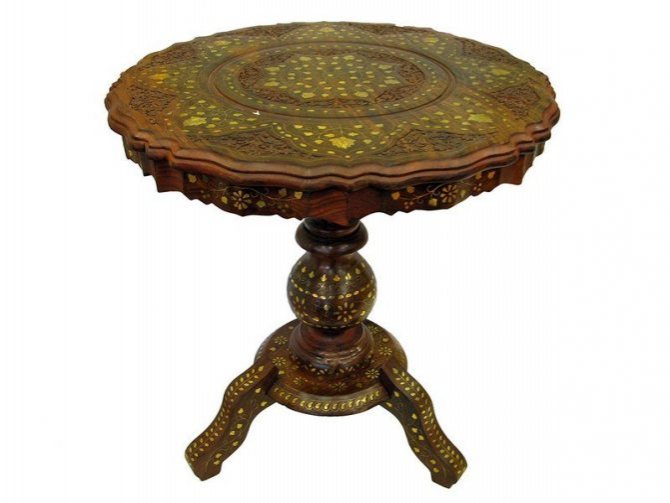

Rosewood table (polysandra)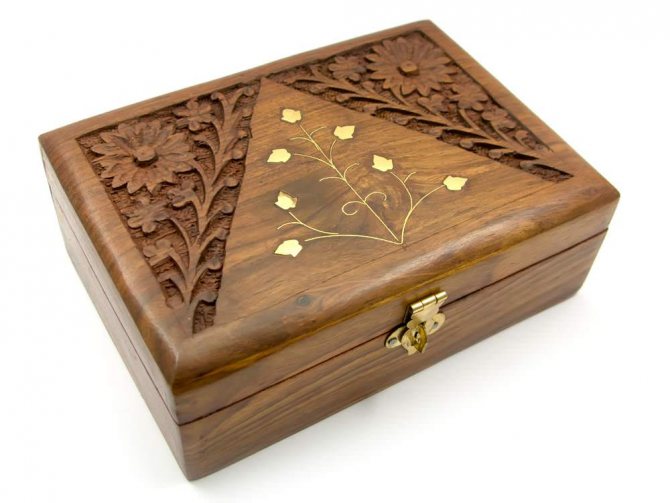

Polysandre box - Due to its strength wood easily amenable to polishing... From the prepared material are created musical instruments, parquet;
- Widely applied in medicine In South America. The plant is used to treat various infectious diseases. Flowers, fruits and leaves are used to make a mixture that helps the body fight infections. This medicine has no side effects.
Jacaranda is a beautiful tree with gorgeous flowers. Proper care of it, taking into account all the features of maintenance and reproduction, will ensure the growth of a healthy tree, which will delight you with its blooming appearance every day.
Possible growing difficulties
Many growers characterize jacaranda as an unpretentious plant that is resistant to diseases and pests. But if the rules of agricultural technology are violated, problems may arise: the leaves turn yellow, curl or fall off, rot the roots, attack pests. To prevent the death of a plant, you need to promptly respond to any changes in its appearance. If the leaves are faded, twisted or yellow, you need to inspect the plant for the presence of pests. Some types of insects are so small that they are not immediately visible. In this situation, you need to treat the plant with a universal insecticidal preparation.
If leaves fall off during winter, this should not be a cause for concern. A natural seasonal process takes place. But if this happened at an unspecified time and quickly, then the reason for this may be a sharp change in the temperature regime in the room or overdrying of the soil. The crown can become thinner if hard water is used for irrigation after drying the soil.
Jacaranda is resistant to fungal infections. But with overflow and stagnation of water, root rot can begin.Good drainage will help to avoid this. An unnatural elongation of the shoots can often be observed. This is the first sign of developing chlorosis. To get rid of the problem, you need to add preparations containing iron to the soil.
With proper care and adherence to all the rules of agricultural technology, you can grow a beautiful plant that will become a real decoration of any interior.
Types of home jacaranda with photos and names
Some types of jacaranda are most often grown at home.
Jacaranda mimosifolia, oval-leaved or round-leaved (Jacaranda mimosifolia, Jacaranda ovalifolia)
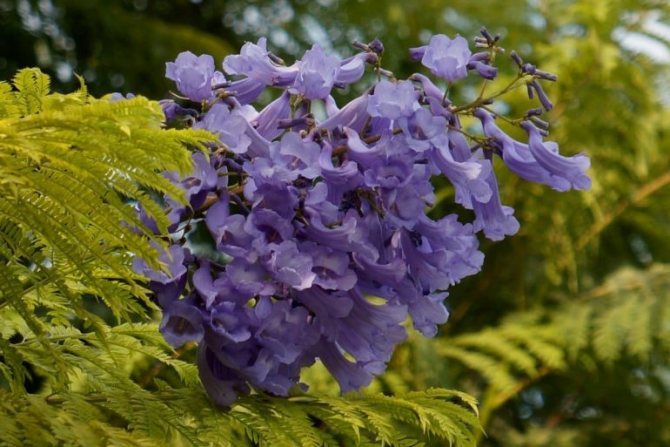

The straight trunk, reaching 3 m, does not branch. Pinnately - divided leaf plates of an elongated - elongated shape. The diameter of the flowers is up to 30 mm, the length is about 50 mm. The petals are bright blue with white dots. Collected in elongated paniculate inflorescences.
Jacaranda fluffy, jasmine, felt Jacaranda jasminoides, Jacaranda tomentosa


In its natural environment, it grows up to 15 meters or more. It has pinnately complex dark green leaves, formed by four pairs of leaf plates, divided into ovoid lobes. Lilac flowers are collected in inflorescences - panicles.
Jacaranda acutifolia


The high (up to 15 m) straight trunk is well branched. Bright green openwork leaves resemble a fern. The tubular flowers are pale blue in color.
Jacaranda fern Jacaranda filicifolia
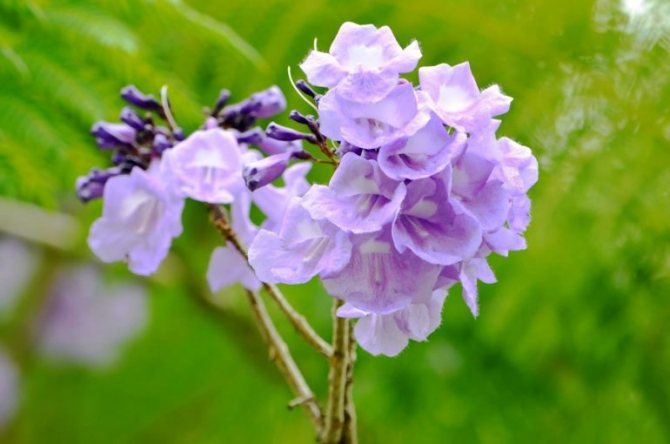

The height of the tree is from 8 m. It has emerald double-pinnate elongated leaves and tubular flowers, painted in lavender tone, forming long (up to 35 cm) panicles.
Jacaranda is an elegant creation of nature, a tree with a spectacular crown. Realizing that it will not always be able to please loving owners with flowering, the plant generously allows it to build intricate structures from its crown.
Fern Jacaranda (Jacaranda obtusifolia)
The species is a deciduous tree, about 4-10 m high, with a poorly formed crown. Leaves are compound, double-leafed, opposite. There are many opposite leaflets, they are scapular elliptical or rhomboid, apex acute, base obtuse. The leaves are curled at the end of long, nearly vertical branches. The ends of the branches bear large pyramidal panicles. The tubular flowers are deep reddish purple in color, much more vividly colored than blue jacaranda. The fruit is a thick, flattened pod with 2 valves. Fern Jacaranda is native to Brazil and neighboring areas.
A little about the tree
Jacaranda is an ornamental, domestic tree that has paniculate inflorescences located in the molding axils or at the top. The flowering tree has a delicate purple color, but depending on the species, it can have blue or even white flowers.
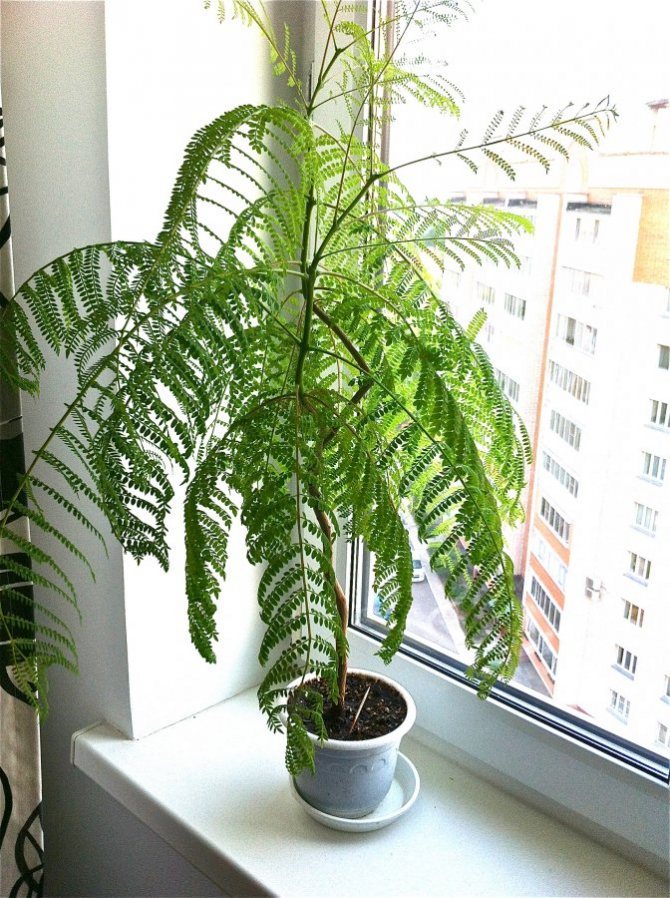

Jacaranda
In nature, rosewood is a valuable material, as its wood is often used in the manufacture of furniture items, tools and much more. The wood itself has a dark brown color, is quite durable and lends itself well to processing.
Jacaranda (violet tree) - short description, history of appearance
In its natural habitat, the plant can be seen in Australia, parts of Asia and South America, but it is most common in Brazil. Jacaranda mimosifolia, as it is also called, or rosewood, belongs to the Bignonium family.
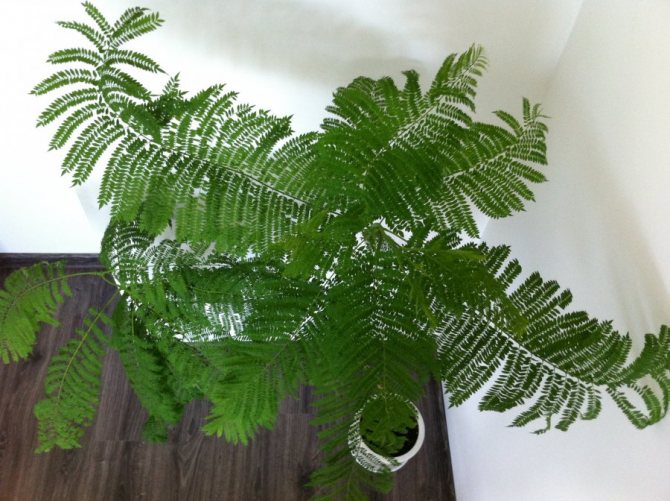

Violet tree
Additional Information. Translated from Portuguese, the name means "hard wood". In Brazil, the tree is also called Black Pui.
Jacaranda is an evergreen tree, in nature it can grow up to 30 meters in height, but there are also 2-meter shrubs. The leaves are feathery, fern-like, and the flowers are bell-shaped and purple in color. However, some varieties may be white.
In addition to its decorative qualities, the plant also finds practical application.Furniture, musical instruments and souvenirs are made from its wood.
Unfortunately, this amazing tree does not grow on the territory of Russia. It is impossible to provide it with a climate similar to a tropical one. You can see the jacaranda in the botanical garden of the Crimea, where conditions are created for it as close as possible to natural ones.
For reference! Although the plant is often referred to as jacaranda, jacaranda, and even jacaranda, the second option is correct.
Jacaranda caucana
It is a species of flowering tree, first described by the Swiss botanist Henri François Pittier in 1917. The species is native to Costa Rica, Panama, the Dominican Republic, Venezuela and Colombia.
Jacaranda caucana is medium in size with a straight barrel. The crown is wide and round, with fern-like leaves that hang almost to the ground. The leaves are small, pointed and divided into leaflets and subcells. Large, purple flowers are formed during the dry season. The fruits are “woody capsules”. The deep purple flowers of the tree make the tree useful as an ornamental tree in gardens.
Liked? Be sure to subscribe to us at,, Zen and


